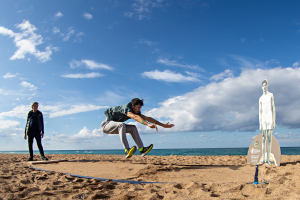LIFE & CULTURE
XpatAthens
Renewables Fully Cover Power Demand For First Time On Record
Independent Power Transmission Operator (IPTO) said on Monday that renewables accounted for 100% of the power generation for at least five hours last Friday, reaching a record high of 3,106 megawatts.
Like other European countries, Greece has cut its reliance on Russian gas following the war in Ukraine by increasing liquefied natural gas (LNG) imports. It has also boosted coal mining, pushing back its decarbonization plan.
The share of renewables from solar, wind, and hydro stood at 46% of the country’s power mix in the eight months to August this year, from 42% in the same period in 2021, according to Greece-based environmental think-tank The Green Tank.
Greece aims to attract about 30 billion of euros in European funds and private investments to upgrade its electricity grid and more than double its green energy capacity to account for at least 70% of its energy mix by 2030.
It plans to have 25 gigawatts of installed renewable energy capacity from about 10 gigawatts now but analysts say Athens might reach that target sooner.
Originally published on: ekathimerini.com
Coeus (Afterlife) Live At Bolivar Beach Club

FokiaNou Art Space - “What Defines Us”
Participating artists: Ines Benaki, John Bicknell, Mary Cox , Panajotis Daramaras, Sarah Ettlinger, Alexandros Georgiou, Marietta Kallona, Nina Kotamanidou, Kelly Koumarianou, Yorgos Kostakis, Despoina Pantazi, Dionisiοs Pappas, Lea Petrou, Geeta Roopnarine, Christina-Sylvia Simantira, Georgia Maggy Touliatou, Panagiotis Voulgaris.
Opening: Thursday, 6 October 18.00
Duration: 6 - 22 October, 2022
Hours: Thursday – Saturday 17.00-20.00
Distinguished Athletes Will Join The 10 Years Celebration Of Navarino Challenge 2022
- The gold and bronze Olympic medalist, 3-time world champion and 6-time European champion in rings, Lefteris Petrounias
- The gold Olympic medalist, world champion and European champion in long jump, Miltos Tentoglou
- The gold Olympic medalist in rowing, Stefanos Ntouskos
- The gymnastics champion, Vasiliki Millousi, with three participations in the Olympic Games and many distinctions in world, European championships and in the Mediterranean Games
- The Greek men’s national water polo team coach that won the silver medal at the Olympic Games, the top team in the world according to FINA and the top team in the the Panhellenic Sports Journalists Association (PSAT) awards in 2021, Thodoris Vlachos
- EuroLeague Legend, Dimitris Diamantidis
- The former international basketball champion and holder of European titles, Georgios Printezis
- The world champion in track cycling, Christos Volikakis
- The three-time bronze world champion in wrestling, Maria Prevolaraki
- The silver world champion in swimming, Kristian Gkolomeev
Alongside them Nasos Ghavelas, Grigoris Polychronidis, Alexandros Nikolaidis, Periklis Iakovakis, Panagiotis Giannakis, Evina Maltsi, Joe Arlauckas, Michalis Triantafyllidis, Georgia Kaltsi, George Lazaridis, Grigoris Souvatzoglou, will be there and compose a unique team that will be united with the event’s participants on October 21-23.
Watch here the running routes of Navarino Challenge, along with all their technical characteristics.
Extensive schedule with numerous actions
This year’s schedule will be the richest ever in the 10-year history of Navarino Challenge. People of all ages and abilities with the message “Sports Unites People” will join this celebration and enjoy unique activities such as:
- Tennis demonstration by the wheelchair tennis player and member of the National team George Lazaridis powered by Miele
- Basketball demonstration powered by Samsung by wheelchair players and members of the National team
- 4on4 basketball tournament by Trace 'n Chase
- Tennis Induction powered by Miele for ages 6–9 and 10–13 years old with the support of Mouratoglou Tennis Center – Costa Navarino
- Bike Tour at Voidokilia with the World Champion in Track Cycling Christos Volikakis powered by Stoiximan in collaboration with Navarino Outdoors
- High intensity training for people of all ages by Dimitris Moros & FitnessArt
- Kick boxing lessons powered by Samsung for people of all ages from the kick boxing champion, Alexandros Nikolaidis
- Baby Swimming Lessons by Red Swim Academy & Swim O' Clock for children up to 3 years old with one parent
- Boxing lessons by Christos Gatsis and Vizantinos Target Sport Club
- Spinning Challenge for people of all ages powered by Vikos with Dimitris Moros & FitnessArt
- Pilates lessons from the team of the pilates instructor Mandy Persaki powered by Samsung
- Yoga by Messinian Spa from FitnessArt
- Men’s Round Robbin Tournament with UTS format powered by Miele with the support of Mouratoglou Tennis Center – Costa Navarino
- Women’s Round Robbin Tournament with UTS format powered by Miele with the support of Mouratoglou Tennis Center – Costa Navarino
- Sea Kayaking to the island of Sphacteria with the support of Explore Messinia
- Gravel Bike Tour 30km at the Kalamaris Waterfall powered by Vikos in collaboration with Navarino Outdoors
- Basketball lessons for children 5 to 16 years old with Dimitris Diamantidis and Georgios Printezis powered by Iroes, together with Evina Maltsi & Joe Arlauckas
- Half day Kids Camp for children 5 to 15 years old with the support of Mouratoglou Tennis Center – Costa Navarino
- Padel tournament powered by Stoiximan with the support of Mouratoglou Tennis Center – Costa Navarino
- Beachathlon powered by Europa (Track and field games for parents & children 6 to 13 years old) by Olympian and European Champion Periklis Iakovakis
- F45 Barrio Salamanca Heavy Cardio Workout by the F45 team together with Dimitris Moros & FitnessArt
- Tsimikas Football Clinics for children 13-17 years & 5-12 years powered by Prosport
- Climbing lessons with Christina Flampouri powered by The North Face, supported by Navarino Outdoors
- King of the Court Women’s Beach Volley Tournament from Triantafyllidis Beach Arena powered by Europa
- King of the Court Men’s Beach Volley Tournament from Triantafyllidis Beach Arena powered by Europa
- King of the Court Mixed Beach Volley Tournament from Triantafyllidis Beach Arena Mixed powered by Europa
- Long jump with the gold Olympic medalist Miltos Tentoglou powered by Stoiximan
- Golf lessons by Bombay Sapphire with the support of Navarino Golf Academy
- Gymnastics by the gold and bronze Olympic medalist in rings Lefteris Petrounias powered by Stoiximan
- Gymnastics by the champion Vasiliki Millousi powered by Iroes
- Rowing lessons from the gold Olympic medalist in rowing Stefanos Ntouskos powered by Stoiximan with equipment from Concept2
- Freestyle wrestling lessons with the world champion Maria Prevolaraki powered by Stoiximan
- “Feed the Fish” Golf Exhibition Game powered by Samsung
- Swimming lessons from the silver world champion Kristian Gkolomeev powered by Stoiximan
- Half marathon powered by Miele
- 10km run powered by Stoiximan
- 5km run powered by Samsung
- 1km run powered by Vikos for children 10-14 years old & up to 9 years old
You can see here the event’s schedule.
Register now for the running activities (21.1km, 10km, 5km, 1km) through the following link.
For group registrations of 10 people or more, a 20% discount applies. For more information, please contact the event organizers.
Live the unique sports experience and stay at The Westin Resort Costa Navarino
Enjoy a weekend with more than 40 activities for people of all ages. Book now the event’s accommodation package with half board and live this year’s unique sports and cultural experience. For more information on accommodation packages at The Westin Resort Costa Navarino you may send your email to booking(at)navarinochallenge.com or call Vita N Travel at +30 210 3249070.
Check the accommodation packages here.
Stoiximan is the event's Grand Sponsor.
Samsung Electronics Hellas supports the event for another year as its Official Technology Sponsor.
Miele and Europa are the event’s Official Sponsors.
Vikos Natural Mineral Water is the Official Water.
Luanvi is the Official Sports Supplier.
Sixt of the Motodynamics group is the Premium Mobility Partner.
Costa Navarino and The Westin Resort Costa Navarino are the Official Hospitality Sponsors.
Poseidonia Restaurant, Karalis Beach Hotel and Bombay Sapphire are Navarino Challenge’s Official Supporters.
Trace ‘n Chase is the Sports Memorabilia Partner.
Kois Optics are the event’s Official Optics Partner.
Messinian Spa is the Official Beauty Partner.
Athens Medical Group is the Medical Partner.
Pilia Express, the transportation company based in Pylos, Pylos-Nestor Municipality and Phee, are the event’s Partners.
SKAI is the Premium TV Partner.
Concept2, Explore Messinia, FitnessArt, F45 Barrio Salamanca, Mouratoglou Tennis Center – Costa Navarino, Navarino Golf Academy, Navarino Outdoors, Pilates by Mandy, Red Swim Academy, Swim O’ Clock, Triantafyllidis Beach Arena, Vizantinos target sport club are Navarino Challenge’s Athletic Partners.
The event is assisted by Vita N Travel and Kayak.
Navarino Challenge will take place under the auspices of the Ministry of Tourism and the Greek National Tourism Organization.
The event has joined the Greek actions of the #BeactiveHellas 2022 program of the European Commission and is held under the auspices of the General Secretariat of Sports.
All running races are co-organized with Messiniakos Gymnastic Club and EAS SEGAS Peloponnese Region.
The event is organized by ActiveMedia Group which is also responsible for the event’s Sports Production.
Hashtags: #navarinochallenge #costanavarino #sportsunitespeople #10yearsNavarinoChallenge #eatwell #runwell #livewell
(photo by Angelos Zymaras @ Navarino Challenge)
ALAN CARR Live In Athens
Alan’s back on the road with a brand-new stand-up show ‘Regional Trinket’. From the exhilarating high of his star-studded wedding day to the low of lockdown stuck on a farm, a lot has changed since Alan’s last tour four years ago, including Alan. Nowadays, it’s all about finding happiness and joy in the small things - why be a national treasure when you can be a Regional Trinket?!
Alan’s unique style of humour and effortless stage presence has made him one of Britain’s most successful and treasured comedians. With 16 series of Channel 4’s Chatty Man under his belt, Alan has won a multitude of awards including the publicly voted 2015 NTA and a prestigious BAFTA in 2013. Alan’s 2015 tour Yap, Yap, Yap saw him perform over 150 dates across the UK and Ireland culminating in the release of his DVD. His previous tour Spexy Beast Live was a 33-date arena tour. The DVD of Alan’s 2007 stand-up show, Tooth Fairy Live topped the HMV charts and was a Christmas 2007 top seller. He has also released two best-selling books Look Who It Is and Alanatomy.
Read more about Alan Carr's upcoming show HERE!
The Meet Market
A collective of talented people, who dove head first into the world of entrepreneurship by creating their own brands, will present their fresh ideas through clothing, accessories, jewelry, art and home-deco items, wellness products, children’s products, organic food, vintage treasures and much more. Come browse, shop, mix, mingle and have a bite at one of our tasty street & drink food stalls featuring various ethnic foods, beers from local microbreweries and boozy cocktails that hit the spot!
PINKTOBER @ Hard Rock Cafe - Breast Cancer Awarness Month
Hard Rock Cafes, hotels and casinos around the world operate for the benefit of the American Cancer Society, while here in Greece we will be collaborating for another year with Alma Zois presenting unique actions during the month of October.
This year, Hard Rock is teaming up with world-renowned French Chef and breast cancer survivor, Dominique Crenn, who is currently the only female chef in the United States to attain three Michelin Stars for her restaurant Atelier Crenn, in San Francisco, California. In partnership with Crenn, Hard Rock Cafe will create a limited-time menu item, exclusively available at Hard Rock Cafes, with a portion of proceeds donated to local charities around the globe.
In collaboration with Crenn, Hard Rock will create and offer a special limited edition dish, the Baja Style Shrimp Tacos exclusively available at all Hard Rock Cafes around the world, with a significant amount of the proceeds being donated to Alma Zois.
Children's Sundays At Hard Rock Cafe Athens!
A unique Sunday afternoon awaits our little Roxtars from 12 pm-4 pm, full of creative work and face painting, along with a delicious children's meal to enjoy!
The entrance for each child is €15 including the meal.
Winter In Greece: A Traveler’s Guide To Visiting In The Cooler Months
Visiting Greece is a very different experience depending on whether you visit in summer or winter, but you are sure to have a great time in the country no matter when you choose to stay!
Visiting Greece in Winter: Where to travel
Although most picture sunny beaches when considering vacations to Greece, the country has a great deal to offer even in the winter months.
One of the most beautiful and unique places in Greece is Meteora, a stunning rock formation in northern Greece which is home to six enchanting monasteries.
The towering cliffs in Meteora, topped by age-old monasteries, are a UNESCO World Heritage site and one of the country’s key tourist attractions. One of the most breathtaking places to visit in Greece, and entirely different from other areas across the country, it is certainly not to be missed.
Another option is the small village of Arachova, a short but scenic two-hour drive from Athens. Arachova is a charming and extremely picturesque mountain town with small houses made of wood and stone that lines cobblestone streets. Perfect for a cold weather getaway, one would find it hard to hold on to stress in such an idyllic and relaxing environment.
Many who visit Arachova do so to enjoy the ski slopes which are nearby. They are equipped with all modern ski facilities, including a lift, ski and snowboard leasing shops, and a chalet.
But just past the village is the ancient site of Delphi, one of the most important archaeological sites in the entire world. Do not miss any chance to see the panorama of this place, showing beautiful ruins against a backdrop of staggeringly beautiful mountains.
Another option for a winter traveler to Greece would be to visit one of the two main cities in the country, Athens or Thessaloniki.
To read this article in full, please visit: greekreporter.com
Greece Sees Record Production From Renewable Energy Sources
The structural upheavals in the energy market brought about by the international crisis also include the fact that Greece became an energy exporter and an energy channel for the Balkan countries, supporting their energy supply with Liquefied Natural Gas infrastructure.
Environment and Energy Minister Kostas Skrekas pointed out that with the increase in RES, Greece has a comparative advantage in electricity production for the first time because it has twice as much solar radiation compared to Northern Europe. He estimated that the production of "green" energy will translate into savings of more than 2 billion euros in 2023 from the substitution of natural gas imports.
The developments in natural gas exports are also impressive with the Liquefied Natural Gas storage and gasification infrastructure in Revythoussa playing a leading role. Skrekas has recently stated at the Ministerial Council of the International Natural Gas Conference in Bucharest, that the country exported 0.7 billion cubic meters of natural gas last year, while this year it is already approaching 2 billion.
Moreover, the country's export potential will be strengthened with the commercial operation of the Greek-Bulgarian natural gas pipeline that began on October 1 and the start of operation, in 2023, of the new floating Liquefied Natural Gas station in Alexandroupolis.
Originally published on: greekcitytimes.com











